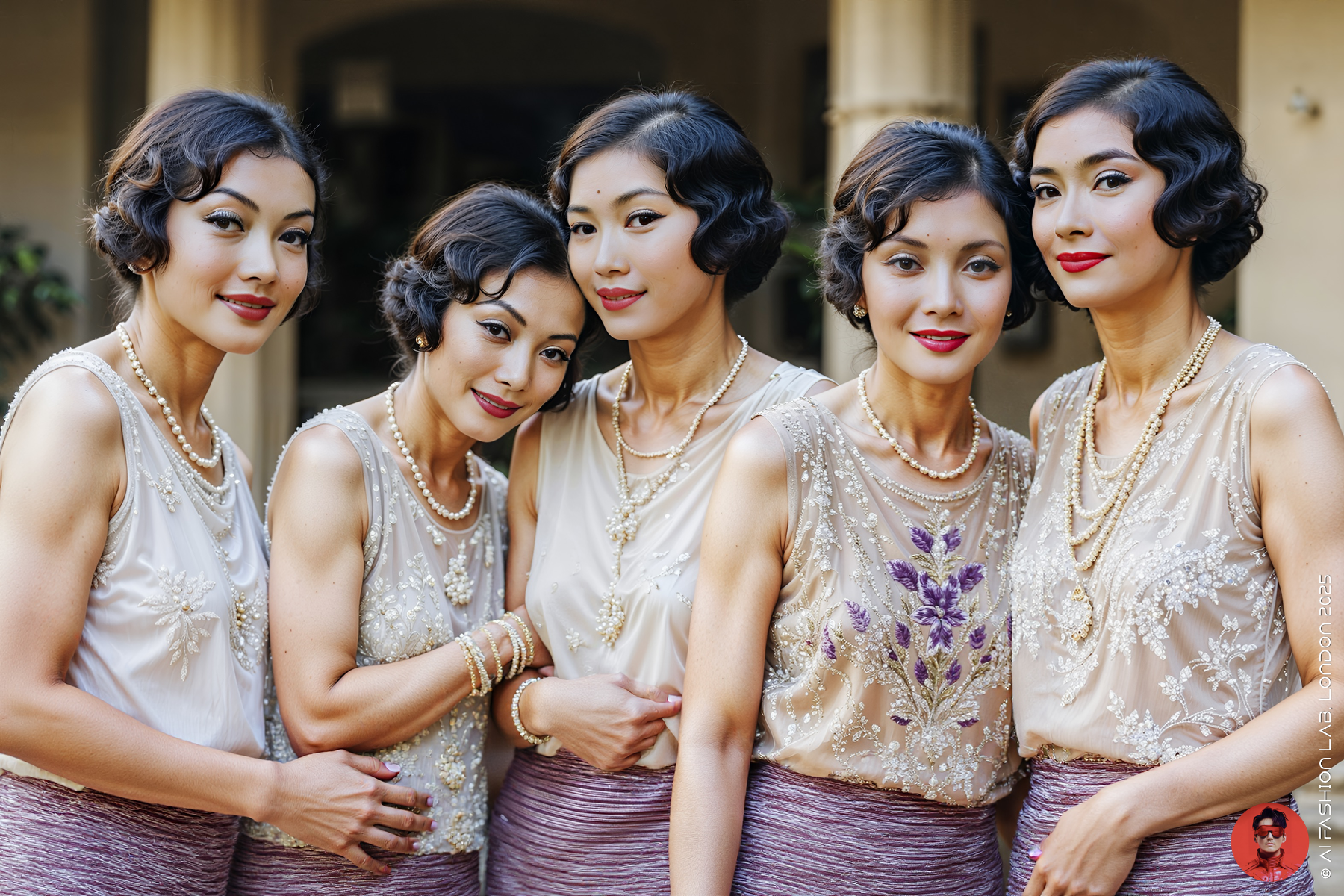ย้อนรอยแฟชั่นและทรงผมแม่ญิงเจียงใหม่: ยุคบ๊อบดัดลอนในเชียงใหม่ยุค 1920s
ย้อนรอยแฟชั่นและทรงผมแม่ญิงเจียงใหม่: ยุคบ๊อบดัดลอนในเชียงใหม่ยุค 1920s
ในช่วงต้นรัชกาลที่ ๗ (พ.ศ. ๒๔๖๘–๒๔๗๘) หรือยุคที่สากลนิยมเริ่มแพร่กระจายจากกรุงเทพฯ สู่หัวเมืองใหญ่ทางเหนืออย่างเชียงใหม่ แม่ญิงเจียงใหม่กลุ่มใหม่เริ่มเปิดรับกระแสแฟชั่นจากโลกตะวันตก โดยเฉพาะอิทธิพลของสไตล์ "แฟลปเปอร์" (Flapper) และทรงผมบ๊อบสั้นดัดลอน ซึ่งเป็นเครื่องหมายของความเปลี่ยนแปลงและความกล้าแสดงออกในยุคหลังสงครามโลกครั้งที่ 1
แม้เชียงใหม่จะยังคงเอกลักษณ์ด้านเครื่องแต่งกายพื้นถิ่น เช่น ผ้าซิ่นตีนจกยกดิ้นทอง ที่ใช้ในโอกาสพิเศษ แต่แม่ญิงบางกลุ่มเริ่มทดลองประยุกต์แฟชั่นตะวันตกกับวัฒนธรรมท้องถิ่นอย่างสร้างสรรค์ ด้วยการสวม เสื้อแขนกุดหรือเสื้อบ่าห้อย ร่วมกับซิ่นที่ปรับความยาวให้สั้นขึ้นเล็กน้อยจากแบบกรอมเท้า เพื่อให้สอดคล้องกับซิลูเอตแบบสมัยนิยมที่เน้นความคล่องแคล่ว
หนึ่งในการเปลี่ยนแปลงที่เห็นได้ชัดคือ ทรงผมบ๊อบสั้น ซึ่งบางรายนิยมดัดเป็นลอนแบบ "ลอนนิ้วมือ" (Finger Wave) ที่ให้ลุคอ่อนหวาน เป็นระเบียบ หรือ "ลอนมาร์เซล" (Marcel Wave) ซึ่งใช้ความร้อนจากอุปกรณ์หนีบเพื่อสร้างลอนที่เด่นชัดและคงทน ลักษณะลอนเหล่านี้สะท้อนอิทธิพลจากสื่อสิ่งพิมพ์และภาพยนตร์ฮอลลีวูด ที่เริ่มเข้ามาผ่านโรงหนังในหัวเมืองใหญ่
แม้แฟชั่นบ๊อบดัดลอนในเชียงใหม่อาจยังจำกัดอยู่ในกลุ่มแม่ญิงชนชั้นกลางที่มีโอกาสศึกษาในโรงเรียนแบบตะวันตก หรือมีความเกี่ยวโยงกับข้าราชการและวงการศาสนา แต่ก็ถือเป็นก้าวสำคัญที่แสดงให้เห็นถึงการเปิดรับวัฒนธรรมสมัยใหม่ และการสร้างอัตลักษณ์ของแม่ญิงรุ่นใหม่ในเมืองเหนือ
คอลเลกชันภาพที่สร้างขึ้นด้วย AI Flux LoRA นี้ คือการจินตนาการว่าแม่ญิงเจียงใหม่ในยุค 1920s จะมีหน้าตา ทรงผม และเครื่องแต่งกายอย่างไร หากเลือกประยุกต์แฟชั่นโลกสมัยใหม่ให้กลมกลืนกับผ้าทอพื้นเมือง เสื้อแบบล้านนา และเสน่ห์ของหญิงชาวเหนือในยุคที่โลกเริ่มรับวัฒนธรรมตะวันตกเข้ามาอย่างรวดเร็ว ภาพเหล่านี้จึงไม่ใช่เพียงการทดลองด้านแฟชั่น แต่เป็นการรื้อฟื้นบทสนทนาว่าด้วย "ความร่วมสมัย" และ "ความงามพื้นถิ่น" ในบริบทของเชียงใหม่ช่วงเปลี่ยนผ่าน
Tracing the Fashion and Hairstyles of Chiang Mai Women: The Bob and Marcel Waves of the 1920s
During the early years of King Rama VII’s reign (1925–1935), as international fashion trends began spreading from Bangkok to major northern cities like Chiang Mai, a new generation of Chiang Mai women started embracing Western influences. Among the most notable changes were the rise of the flapper silhouette and the adoption of short bobbed hairstyles with soft waves—symbols of social transformation and modern self-expression in the post–World War I era.
Although Chiang Mai women continued to honour their cultural heritage through traditional garments—particularly the “teen jok yok din thong” textiles, with their intricate gold-threaded patterns at the hem—some began experimenting with creative hybrids. These included pairing sleeveless corset-cover-style blouses or “seua ba hoi” shoulder-draped tops with modified sin skirts that were slightly shortened from floor-length to mid-shin, echoing the flapper’s more practical silhouette.
One of the most striking markers of modern femininity at the time was the short bob hairstyle, often styled in delicate “finger waves” for a soft, orderly look. Others preferred the more defined “Marcel waves,” created with heated metal irons for deeper, longer-lasting curls. These elegant styles mirrored the growing influence of Hollywood cinema and Western fashion media, which had begun to reach provincial cities through imported films and printed publications.
Though this modern style remained mostly confined to educated middle-class women—particularly those in missionary schools or government circles—it nevertheless signalled a significant cultural shift. These women of Chiang Mai were not merely imitating Western trends; they were actively integrating them with local identity, crafting a new northern aesthetic for the modern Siamese woman.
This AI-generated Flux LoRA collection offers a creative re-imagination of how Chiang Mai women in the 1920s might have dressed and styled themselves had they fully embraced global fashion while preserving the richness of local textile traditions. These images do more than illustrate experimental fashion—they reopen the conversation on what “contemporary elegance” meant in a time when women in Chiang Mai stood at the crossroads of heritage and modernity.
#aifashionlab #AI #aiartist #aiart #aifashion #aifashiondesign #aifashionstyling #aifashiondesigner #fashion #fashionhistory #historyoffashion #fashionstyling #fashionphotography #digitalfashion #digitalfashiondesign #digitalcostumedesign #digitaldesign #digitalaiart #ThaiFashionHistory #ThaiFashionAI #flux #ComfyUIFluxLoRA

















































